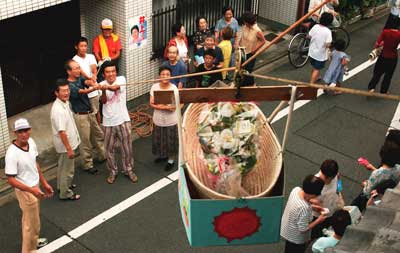:::::::::::::::::::::::::::::::::::::::::::::::::::::::::::::::::::::::::::::::::::::::::::::::::::
Torch Fire Festival (Otomatsuri)
***** Location: Japan, Wakayama
***** Season: Early Spring
***** Category: Observance
*****************************
Explanation
Torch Festival, O-too matsuri 御灯祭, お燈まつり, 御燈祭
Held in Kumano, in the town of Shingu at the shrine Kamikura Jinja 和歌山県新宮市の神倉神社.
February 6.
This fire festival has a history of more than 1400 years. It welcomes the God of the New Year and was held on the six day of the first month, according to the Asian lunar calendar.

Copyright (C) 2007 JTB Publishing Inc.
Men of all ages, called "those who climbed up, agari ko 上り子, run down the 538 steep stone steps of the mountain shrine, in complete darkness, each carrying a torch, which was lit before the festival on the sacred flame of the shrine.
They wear white cloths to express their will to be "deadly serious" about this. White cloths (shini shoozoku 死に装束, shiro shoozoku 白装束)are worn by many mountain ascetics.
On the night of the festival, men eat only WHITE food, such as cooked white rice, white rice cakes and radish.
The first one to reach the bottom of the stairs used to get a barrel of rice in former times. Nowadays, it is just for the thrill of it. The first few men are called "Tengu", mountain goblins, for being able to make it in such a short time.
More than 2000 men gather every year within the small mountain shrine compound and wrangle for the best place closest to the gate, which is opened at eight o'clock.
Many train all year to get a feeling of the unregular, small stone steps, the curves and problems of the dangerous way down.
Some fathers carry their baby sons on the back, stepping very carefully so as not to fall in the dark.
They take the torches home, place them on the shelf for the gods (kamidana 神棚) and pray for the good luck of the whole family in the coming year.
The whole mountain area of Kamikura is usually off limits for female persons (nyonin kinsei 女人禁制). Mothers, wifes and grandmothers wait at the bottom of the path and pray for the safe return of their menfolk.
Gabi Greve, February 2007
Click HERE to look at more photos !
otoumatsuri
From the song of the shrine Shingu:
「お燈まつりは男のまつり 山は火の滝、下り龍」
This is a festival for real men ! The mountain becomes a waterfall of fire, a Dragon coming down !
:::::::::::::::::::::::::::::::::::::::::::::::::::::::::::::::::::::::::::::::::::::::::::::::::::::
Kumano Hayatama Taisha
includes the compound of the shrine situated near the river mouth of the Kumanogawa River, as well as Mt "Gongenyama 権現山" in the background, where Kamikura-jinja is located, and the ritual sites Mifunejima and Otabisho. Halfway up Mt Gongenyama there is a shrine called Kamikura-jinja, where it is believed that the shrine deity had descended. Around the gigantic rock called Gotobiki-iwa, which has itself been worshiped as a sacred object, many bronze bells of the 3rd century and sutra mounds of around the 12th century have been found.
Annually on the 6th of February the fire festival called Kumano Otomatsuri is held; this festival, which is said to retain its ancient religious traditions, was originally observed on the 6th day of the lunar-calendar New Year.

Read more about the area of Kumano HERE
© Okayama Prefecture : Kumano
:::::::::::::::::::::::::::::::::::::::::::::::::::::::::::::::::::::::::::::::::::::::::::::::::::::
Part of the stone steps on the path, a feat to climb up even in summer daylight.

© PHOTO Wikipedia
*****************************
Worldwide use
*****************************
Things found on the way
TANAKA,Masaaki [Otoumatsuri – Wakayama Pref]
Woodblock of this festival
*****************************
HAIKU
complete darkness -
a dragon of fire races
down the steps
Gabi Greve, 2007

© PHOTO : www.kumano-monogatari.com/
*****************************
Related words
***** . Nachi no himatsuri 那智の火祭り Fire Festival at Nachi
main festival at shrine Nachi Taisha, July 14.
***** Fire Festivals of Japan (hi matsuri)
::::::::::::::::::::::::::::::::::::::::::::::::::::::::::::::::::::::::::::::::::::::::::::::::::

























